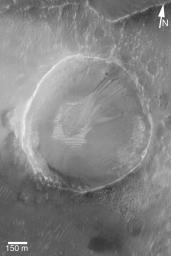Small Gullied Crater
Caption:
18 November 2004
Middle- and polar-latitude martian gullies remain as much a mystery today as they were when first announced in June 2000. Some have argued that they form by running water, others argue they required carbon dioxide in liquid or gas form, still others have proposed that these features form "dry" by simple landsliding processes (although landslides elsewhere on Mars do not form features that look like the martian gullies). They occur almost exclusively at latitudes higher than 30° in both hemispheres, although they are more common in the southern hemisphere. This Mars Global Surveyor (MGS) Mars Orbiter Camera (MOC) image shows a very small gully example in a crater that is only about 1 km across -- roughly the size of the famous Meteor Crater in northern Arizona. The debris transported through the gullies was deposited on top of light-toned, windblown ripples on the floor of the crater, indicating that the ripples are older. This crater is located near 37.9°S, 169.3°W. The 150 meter scale bar is about 490 feet long. Sunlight illuminates the scene from the upper left.
Cataloging Keywords:
| Name |
Value |
Additional Values |
| Target |
Mars |
|
| System |
|
|
| Target Type |
Planet |
|
| Mission |
Mars Global Surveyor (MGS) |
|
| Instrument Host |
Mars Global Surveyor |
|
| Host Type |
Orbiter |
|
| Instrument |
Mars Orbiter Camera (MOC) |
|
| Detector |
|
|
| Extra Keywords |
Crater, Grayscale, Water |
| Acquisition Date |
|
| Release Date |
2004-11-18 |
| Date in Caption |
2004-11-18 |
|
| Image Credit |
NASA/JPL/Malin Space Science Systems |
| Source |
photojournal.jpl.nasa.gov/catalog/PIA07060 |
| Identifier |
PIA07060 |

